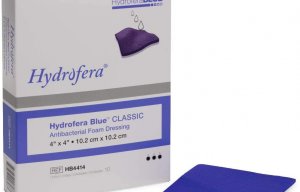
Essity acquires Hydrofera
The aim of the project was to develop a biotechnological process to produce alginate and then process it into fibre-based products for use in wound dressings.

28th July 2016
Innovation in Textiles
|
Boennigheim/Zwingenberg/Kelheim
In a joint project called AlBioTex, researchers at the Hohenstein Institute, B.R.A.I.N AG and Kelheim Fibres have successfully developed wound dressings made from bacterial alginate.
The aim of the project was to develop a biotechnological process to produce alginate and then process it into fibre-based products for use in wound dressings. The soil bacterium Azotobacter vinelandii was used as a natural alginate resource.

This means that the conventional, time-consuming process of obtaining the biopolymer from brown algae can be avoided and replaced by a sustainable biotechnological process, researchers report.
Alginate is a biopolymer (polysaccharide) that consists of the glycosidically bonded monomers, guluronic and mannuronic acid. The range of industrial applications for the biopolymer is determined by the sequence and ration of these two sugar components. Alginate is particularly suitable for use in wound dressings because of its excellent biocompatibility, enormous liquid-absorption capacity and good healing properties.
The conventional alginate that is obtained from algae varies greatly in the composition of its sugar components, because of environmental factors. A time-consuming preparation process is required to obtain the ultrapure and biochemically defined alginate that is needed for medical applications, for example.
Using biotechnology to produce alginate, on the other hand, is said to offer the option of synthesising biopolymers which have defined properties and are of consistent quality for use in medical products, according to a team of researchers.
Research work that began in 2013 has been able to establish, optimise and standardise the cultivation of the soil bacterium and the biotechnological process for producing and isolating bacterial alginates.

By working specifically on optimising the bacterium's alginate biosynthesis, the researchers succeeded in improving the composition, and therefore the properties and yield of the alginate. This meant that they could make customised alginates that are particularly suitable for producing fibres for use in medical products.
In a pilot production facility, the research partners were able to spin fibres from alginate and alginate-viscose, and turn them into innovative nonwoven materials and wound dressings within the established process. When the new wound dressings were tested in use, the alginate product that had been made using biotechnology was impressive for its liquid absorption capacity, which was significantly better than that of commercially available marine alginate-based wound dressings. The bacterial wound dressings absorbed up to 70% more liquid than marine-based dressings.
“The results that were achieved from this successful research project will form the basis for incorporating bacterial alginate in industrial production,” declared Dr Guido Meurer, a member of the Management Board of BRAIN AG.
“Now our next goal for the future is to identify other areas of application for bacterial alginate and so open up new sales markets for customised special alginates,” added Dr Daniela Beck from Kelheim Fibres.
Prof Dirk Höfer of the Hohenstein Institute, concluded: “Until now it has been impossible, or very difficult, to vary and optimise the material properties of alginate. Thanks to biotechnology, there is now nothing to prevent the targeted use of alginate in specialist textiles.”

Business intelligence for the fibre, textiles and apparel industries: technologies, innovations, markets, investments, trade policy, sourcing, strategy...
Find out more